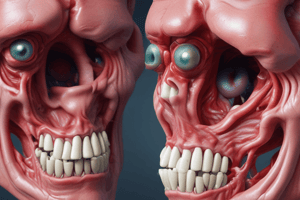Podcast
Questions and Answers
Which branch of the trigeminal nerve is responsible for sensation in the upper eyelid?
Which branch of the trigeminal nerve is responsible for sensation in the upper eyelid?
- Mandibular division
- Maxillary division
- Facial nerve
- Ophthalmic division (correct)
Which nerve is responsible for sensory innervation of the lower lip?
Which nerve is responsible for sensory innervation of the lower lip?
- Supratrochlear nerve
- Mental nerve (correct)
- Zygomaticofacial nerve
- Infraorbital nerve
What is the primary function of the facial nerve (CN VII)?
What is the primary function of the facial nerve (CN VII)?
- Innervating facial muscles (correct)
- Regulating blood flow in the head
- Carrying sensation from the face
- Controlling eye movement
Which branch of the facial nerve innervates the buccinator muscle?
Which branch of the facial nerve innervates the buccinator muscle?
From which structure does the facial nerve emerge?
From which structure does the facial nerve emerge?
Which of the following nerves is NOT a branch of the maxillary division of the trigeminal nerve?
Which of the following nerves is NOT a branch of the maxillary division of the trigeminal nerve?
Which nerve carries sensation from the skin of the forehead?
Which nerve carries sensation from the skin of the forehead?
What is the innervation pattern for the temporal branch of the facial nerve?
What is the innervation pattern for the temporal branch of the facial nerve?
What is the primary function of the orbicularis oculi muscle?
What is the primary function of the orbicularis oculi muscle?
Which muscle is responsible for compressing the cheek against the teeth?
Which muscle is responsible for compressing the cheek against the teeth?
Where does the platysma muscle originate?
Where does the platysma muscle originate?
Which artery supplies blood primarily to the face and branches into labial arteries?
Which artery supplies blood primarily to the face and branches into labial arteries?
What role does the orbicularis oris muscle play physically?
What role does the orbicularis oris muscle play physically?
Which artery gives off the transverse facial artery?
Which artery gives off the transverse facial artery?
How does the action of the buccinator muscle aid during eating?
How does the action of the buccinator muscle aid during eating?
Which muscle is primarily associated with facial expressions and also influences the neck area?
Which muscle is primarily associated with facial expressions and also influences the neck area?
Flashcards are hidden until you start studying
Study Notes
Orbicularis Oculi Muscle
- Located in the eyelids, encircles the eyes, facilitating both gentle and forceful closing of the eye.
- Plays a vital role in blinking and squinting, aiding tear movement across the conjunctival sac to maintain cornea moisture.
Orbicularis Oris Muscle
- Encircles the mouth, responsible for bringing lips together to keep the mouth closed.
Buccinator Muscle
- Originates from the pterygomandibular raphe and extends into the cheek, blending with the orbicularis oris.
- Functions to compress cheeks against teeth, aiding in food manipulation during chewing.
- Utilized in playing musical instruments and controlling air expression.
Platysma Muscle
- Spans from skin over the mandible, through neck fascia into upper chest skin.
- Assists in tightening skin and depressing mouth angles, categorized within facial expression muscles.
Facial Artery
- Supplies blood to the face via branches from the external carotid artery.
- Crosses the mandible in front of the masseter muscle; tortuously travels to the medial eye angle, where it connects with the ophthalmic artery.
- Provides labial branches, with the superior labial artery supplying the nasal vestibule.
- Scalp blood supply also comes from the occipital, posterior auricular, and superficial temporal arteries, all originating from the external carotid artery.
- The transverse facial artery branches from the superficial temporal artery, running parallel to the parotid duct.
Trigeminal Nerve Sensation Innervation
- Ophthalmic Division (V1): Supplies sensation from the upper eyelid, forehead skin, and nose via the lacrimal, supraorbital, supratrochlear, and nasal nerves.
- Maxillary Division (V2): Carries sensation from the lower eyelid and upper lip, with branches including infraorbital, zygomaticofacial, and zygomaticotemporal nerves.
- Mandibular Division (V3): Provides sensation to the lower lip, lower face, auricle, and frontal scalp through mental, buccal, and auriculotemporal nerves.
Motor Innervation of Facial Muscles
- All facial expression muscles receive innervation from branches of the facial nerve (CN VII).
- After exiting the stylomastoid foramen, the facial nerve traverses the parotid gland, splitting into five terminal branches:
- Temporal Branch: Innervates occipitofrontalis and orbicularis oculi.
- Zygomatic Branch: Innervates orbicularis oculi.
- Buccal Branch: Innervates buccinator, orbicularis oris, and muscles affecting the nose and upper lip.
- Mandibular Branch: Innervates orbicularis oris and muscles acting on the lower lip.
- Cervical Branch: Innervates platysma muscle.
Studying That Suits You
Use AI to generate personalized quizzes and flashcards to suit your learning preferences.




